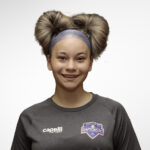Concussions: Not just a bump on the head (Part 1 of 2)
By Dr. Wendy Lebolt
[Editor’s note: This is the latest column from Dr. Wendy Lebolt, a longtime coach and physiologist who is the founder of Fit2Finish, a Northern Virginia-based training, fitness and rehabilitation company which works with teams and individual players to maximize health and performance. The Soccer Wire is excited to present Wendy’s learned perspectives on the mental, physical and psychological aspects of the beautiful game. Learn more about her background here.]
The kid is everywhere. She’s taking command of the midfield and dictating play. Balls in the air. Balls on the ground. Nothing gets past her. She camps under another punt, and tenses, ready to send it forward. She goes up for ball, but so does their striker. Heads, elbows and ball collide. Both girls collapse to the ground. One doesn’t get up. The whistle blows.
This scenario is played out, unfortunately, thousands of times every weekend in this country on a field near you, and your own team, players or children have probably been involved at some point. Soccer players collide with each other, the ball, the goal post or the ground and are slow to get up. Even if they get up on their own, are they safe to keep playing? If you sit them, can they return to play? As coach, parent or player, how do you make this call?
Lots of ink has recently been devoted to the dangers of concussions sustained in sports and especially to the risk in our youth athletes. As many as 3.8 million recreational and sports-related concussions are reported annually in this country, and that number has skyrocketed in the last decade. Behind football, soccer players swell those ranks, with girls facing twice the risk as boys in comparable sports.
Concussion is considered a mild traumatic brain injury which occurs as the result of a blow to the head or body with force transmitted to the head. It’s an acceleration of the brain inside the skull (whiplash-like), which results in temporarily impaired brain function. Let me not downplay the significance of this injury: A shaking of the brain on its brain stem root that disrupts brain cell nerve transmission in visual, spatial and executive function regions. It may even cause a sheering of the nerves that run between the brain’s two hemispheres. It’s serious.
The player does NOT need to lose consciousness to have a concussion. If you suspect a concussion, here are signs and symptoms to look for:
• Headache
• Dizziness and/or nausea
• Impaired balance
• Blurred vision and/or light sensitivity
• Dazed or stunned affect
• Confusion or mental fogginess
• Impaired memory – they answer questions slowly or repeat questions
Athletes with any of these symptoms should be sent straight to their doctor or to the emergency room:
• Headaches that worsen
• Seizures
• Neck pain
• Marked drowsiness
• Repeated vomiting
• Slurred speech
• Increased confusion and/or inability to recognize people or places
• Weakness or numbness in the arms or legs
• Unusual behavior change, including increased irritability
• Loss of consciousness
We used to call this “getting your bell rung.” There was almost a badge of honor awarded to the player who could tough this out and keep going. This is still happening, says Paul Rupp, head Athletic Trainer at Oakton High School in Vienna, Va.
“Players may not report their symptoms because they don’t want to come out of the game,” said Rupp. That means coaches and parents have to turn up the vigilance. We need to err on the side of caution with these kids.
That’s what high schools around the Washington, D.C. area are doing.
“All freshman and junior athletes, those new to athletics at Oakton and any who have had a concussion are required to undergo the ImPACT test,” explained Rupp.
This is a computerized test of cognitive function used to establish baseline brain function. (http://www.impacttest.com/) It assesses verbal and visual memory, processing speed and reaction time.
At Oakton that amounts to about 450 tests per year. It takes about 20 minutes to instruct and 25 minutes to administer. The instruction is critical, according to Rupp, who uses the opportunity to explain the signs of a concussion to the athlete, assess player head injury history, and identify individual distinctions like learning disabilities that might affect the test.
“I always tell them, ‘Don’t tank this test,’” he noted.
I’m incredulous; they fail it on purpose? They might try, he says. They think they can do poorly and then if they get knocked their responses to the field evaluation will be similar and they will can get back into the game. This won’t work, Rupp assured me. Head injury delays will be different from what they do on purpose. And he always tells them that if he suspects they haven’t done their best he will have no choice but to err on the conservative side and sit them for longer. Rupp’s been standing guard at Oakton for 12 years now. He’s no-nonsense when it comes to the athletes.
Oakton has seen a significant number of concussions this year.
“We’re high in the county [Fairfax]. It’s just our year for this injury,” he observed, noting that injuries seem to come in bunches. “One year it’s ankles. Another it’s ACLs. This year, it’s concussions.”
I’m not so sure. The trend toward so many concussions seems huge. Every coach I talk to is down a few players to this injury. Football, the ugly American style, is the worst offender. But nationally, soccer comes in second. It’s first among girls’ sports.
Why so many? Why now? Why our girls? Rupp has a few speculations. Certainly, we are all getting more educated on this injury, so reporting has gone up. Rupp also confirms what I have seen, that heading technique is different in girls. Boys attack the ball. Girls let it hit them. Boys, with stronger necks and upper bodies, use their torso to head. Girls hunch shoulders and bring their arms across their chests trying to make up the difference. No go.
But why are our adolescents barraged by it now? We’ve been heading the ball forever. And women have done their share in recent decades. Rupp has an interesting idea: kids are using their brains differently these days.
He stops short of hypothesizing an actual change in their brains – although there are those, like Nicholas Carr, author of “The Shallows: What the Internet Is Doing to Our Brains,” who do – but points to the techno-demands on adolescents today: communication, entertainment, homework. All this at a time when the brain is rapidly changing. Combine more collisions with more plugged-in brains, add gray matter with a bit of room to grow (and rattle) in the cranial space, and you have an explosive combination.
So, do you tell them not to head it? Rupp agrees with others who say that heading is still safe, if done properly. In the face of so many concussions, his main concern is the athlete’s safe return to play.
How do you safely return a kid to play?
Editor’s note: Click here to read part two, where Wendy discusses this important element with Rupp, and explains what parents, coaches and officials can do to stem the tide of youth soccer’s troubling concussion epidemic.
SOCCERWIRE MARKETPLACE
- visitRaleigh.com Showcase Series 2025, hosted by NCFC Youth
- OFFICIAL MANCHESTER CITY SOCCER CAMPS
- Wanted Licensed Youth Soccer Coach
- Join Official Elite Summer Soccer Camps with Europe’s Top Pro Clubs!
- The St. James FC Travel Staff Coach - North (Loudoun) & South (Fairfax)
- The St. James FC Girls Academy (GA) Head Coach - 2 teams
- The St James FC Boys Travel Tryouts
- OFFICIAL BAYERN MUNICH SUMMER CAMPS U.S.
- JOIN THE ALLIANCE!
- OFFICIAL FC BARCELONA CAMPS U.S.











